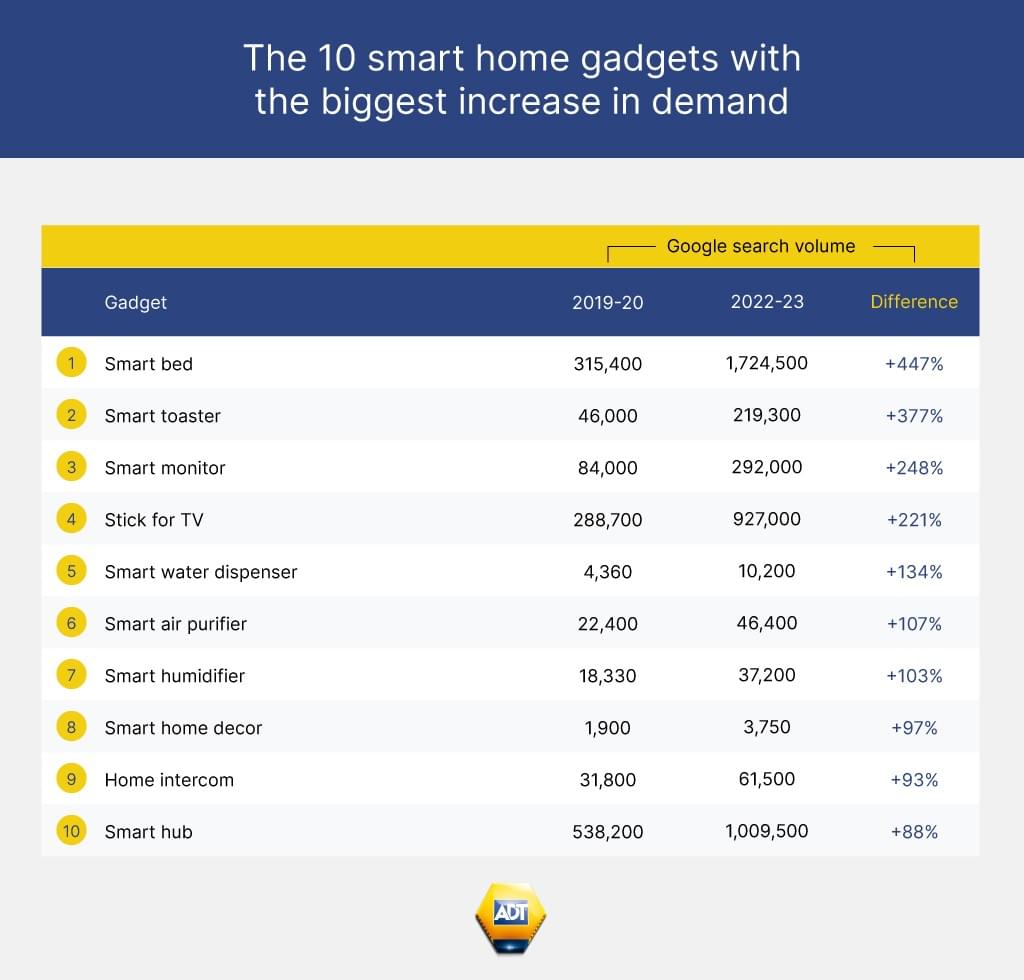Homes of the future
Smart home automation is on the rise, with around 2.2 million homes in the UK classed as smart homes.¹ As the pace of technological change picks up, the team at ADT have revealed the smart home gadgets most likely to be popular in the next few years.
The 10 smart home gadgets with the biggest increase in demand:

Smart beds take the top spot with a 447% increase in Google searches. Smart beds provide personalised comfort with customisable firmness and adjustable temperatures and some can even track health metrics and sleep patterns. With the average person spending one-third of their life asleep², it is likely demand for smart beds will continue to grow.
With the second-highest surge in demand, smart toasters have had a 377% increase in searches. Smart toasters work with sensors to produce a perfectly personalised toasted product for each use, doing so in just a fraction of the time as regular toasters.
Rounding out the top three are smart monitors with a 248% increase in searches. Since the rise of hybrid working, smart monitors have often been used in homes as extra screens for workers. However, smart monitors can also be wirelessly connected to your laptop, desktop, or phone, combining work with entertainment, making their popularity probable to continue.
Michele Bennett, General Manager at ADT has commented on whether appliances in the home will be eradicated and if we will see a change in how people use their homes:
“Consumers are always looking for more personalised and seamless experiences, especially when it comes to their home - searches for app or voice-controlled appliances such as smart plugs have increased by 52%. ADT products allow you to use smart algorithms and geo-fencing settings, which users can switch on/off devices plugged into smart plugs from their phones at any time, with these devices providing users with practical, convenient and tailored experiences with little effort.
“The recent rise of artificial intelligence is also likely to play an important role in changing how people use their homes in the next 15 years. Instead of having to set up your household’s routines, AI will do this for you by tracking your behaviour patterns. For example, if you’re leaving for work and didn’t turn off all the lights, your smart system will do this for you automatically. Ultimately, AI will help your house perform tasks that humans used to.
“In terms of security, home security systems have seen a 15% increase in Google searches with people wanting to keep an eye on and secure their homes from any location. ADT’s smart home security systems work around you and your daily routine, meaning the systems can arm and disarm around a pre-set schedule, but will also arm itself if motion isn’t detected in your property. Additionally, smart security products can provide more reliable security than traditional, manually operated security systems. Cameras equipped with intelligent motion detection can distinguish between people, vehicles and animals, meaning you'll only be notified about what matters most to you, and perimeter guards on cameras with two-way audio allow you to see, hear and speak to any unwanted visitors near your property, as well as deter them with an audible siren.
“The appeal of smart houses and gadgets is the management and monitoring that can happen while you're not home - with the right setup, a smart home will be able to run and secure itself when you're out running errands or at work. As we continue to see new technologies become integrated into homes the manual household will decline, making way for the rise of the more customised and automated one.”